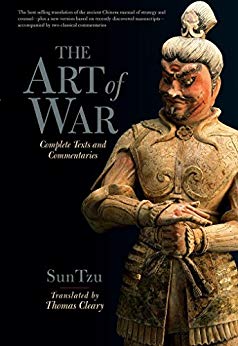

This article is an excerpt from the Shortform summary of "The Art of War" by Sun Tzu. Shortform has the world's best summaries of books you should be reading.
Like this article? Sign up for a free trial here .
In Sun Tzu’s The Art of War, the author advises that “in the midst of chaos, there is also opportunity.” What does Tzu mean by this?
We’ll cover what’s involved when mobilizing an attack, how to use both orthodox and unorthodox actions to confuse your opponent, and what Tzu means when he says, “In the midst of chaos, there is also opportunity.”
Mobilizing an Attack
Using force means allowing the momentum of the conflict to move your hand. A good leader allows momentum, not the brawn of the troops, to provide efficiency of strategy. Let momentum work in your favor, and victory will require little effort. Momentum may be chaotic, but in the midst of chaos, there is also opportunity.
Momentum can be created by manipulating your opponents. Make your opponents follow the path you lay out for them. When they are on your path, you know when and how to attack.
- Assuming a formation to create a false perception of your troops will cause your opponent to take a certain shape, one you’ve manufactured and control.
- Dangle a carrot in front of your opponent by convincing them of manufactured gain, and you will know what their next move will be.
When you force your opponent into action, you can see the ins and outs of their preparedness and strength. You can determine their behavior patterns when you create scenarios where they are forced to act.
Orthodox vs. Unorthodox Action
In battle, fighting is unremarkable. It is straightforward in action. But victory is attained through the remarkable. Unremarkable and remarkable actions are also referred to as orthodox and unorthodox actions, respectively.
Both orthodox and unorthodox actions are taken during conflict. Ensuring victory means having a command of both orthodox and unorthodox actions. Unorthodox actions are chaotic, but remember, in the midst of chaos, there is also opportunity.
Orthodox actions are straightforward techniques—tried and true behaviors and formations.
- For example, fighting on the front lines or attacking a valuable territory are orthodox actions.
Unorthodox actions are surprise attacks and other maneuvers outside the typical boundaries of battle.
- For example, ambushes and deception are unorthodox tactics.
Orthodox and unorthodox tactics should be blended to work in harmony. Like the endless combination of colors derived from the five primary colors, there are multiple variations encompassed within the primary actions of orthodox and unorthodox behaviors.
- Orthodox behavior is always direct, and unorthodox behavior is always a surprise.
- But the manifestation of each is endless in its possibilities.
Manipulate what your enemy views as orthodox and unorthodox behaviors. By feigning orthodox behavior, you set your opponent up for attack through unorthodox action. For instance, disorganization emerges from organization, fear emerges from bravery, and vulnerability emerges from strength.
- If you want to appear unorganized, you must first be organized.
- If you want to appear cowardly, you must come from a place of courage.
- If you want to appear weak, you must start from a foundation of strength.
- These deceptions will mislead your enemy.
Deception is a great way to gain information about your opponent. If they think you are weak and they attack, you know the level of their aggression and greed.
Any time you can confuse or deceive the opponent, you force them to adapt. In these adaptations, you can discern their patterns of movement, strength of force, and tendencies to react.
- This information becomes useful in determining how to strategize against them.
- You will know in which situations they will fight and which they will run.
- You can determine when lives will be threatened and when lives can be saved.
- You can find out where the gaps in their strength are, otherwise known as vulnerabilities.
- With this information, you can strategize when attacking is beneficial and when defending is more beneficial.
Do not repeat tactics or strategies. The possibilities of orthodox and unorthodox actions are endless, so constantly adapt both to serve the momentum and remain mysterious.
In the Midst of Chaos, There Is Also Opportunity
Use chaos strategically. It is not enough to simply feign orthodox behaviors to make your enemy vulnerable to unorthodox attacks. Even if you have organization, bravery, and strength on your side, if you do not adequately address the five traits of success, the result will be actual disorganization, fear, and vulnerability.
Some situations can give a misleading appearance of preparedness. For example, when momentum is on your side, even the fearful can find courage. Relying on this fraudulent strength is foolhardy. If you lose the force of momentum, the courageous can become scared.
Determine the strength of your forces based on merit, then place them appropriately to benefit from momentum. If you position your troops in this way, your strength becomes like a boulder rolling downhill. By the time the boulder reaches the bottom, its velocity makes it unstoppable.
Historical Example: Exploiting Momentum and Chaos
In 265 C.E., the martial emperor of Jin defeated Cao Cao’s forces in the north and wanted to overthrow another kingdom, the Wu, to gain supremacy in the south. One of Jin’s generals won a small battle against a faction of the Wu’s military. The general then asked for permission to carry out a full assault on the Wu. Knowing the large amount of strength, supplies, and men it would take to overthrow the Wu, the emperor denied the request, suggesting they wait a year to prepare.
The general, in response, cautioned that their plans against the Wu are now apparent. The Wu could begin preparations during the year in anticipation of an assault. The general stated that the momentum was on their side currently, and the likelihood of victory at that moment was large compared to their chances in the future. The emperor agreed, and the general was successful in taking over Wu territory easily.
Remember, in the midst of chaos, there is also opportunity.
———End of Preview———

Like what you just read? Read the rest of the world's best summary of "The Art of War" at Shortform . Learn the book's critical concepts in 20 minutes or less .
Here's what you'll find in our full The Art of War summary :
- How to mislead your enemies to win the war
- Classic examples from Chinese history to illustrate Sun Tzu's strategies
- How to use spies to gather information and defeat your opponents






